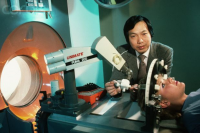Dr. Yik San Kwoh is the inventor of robot/software interface program used in the first robot-aided surgery. He poses near the robot as it demonstrates its technique, simulating inserting a biopsy needle into model Jackie Kiranoff's head.
Dr. Yik San Kwoh of Memorial Medical Center of Long Beach, who developed the computer program that makes the arm work, said the device will shorten the hospital time for patients with brain tu-mors.
The average stay, from five or more days, will shrink to about one day, saving money and recovery time for the patient, he said.
The procedure, he added, also will eventually save lives.
The robotic arm, developed by Unimation, a subsidiary of Westinghouse Corp., is called the Unimate Puma 200, but doctors and researchers who work with it call it ``Ole,`` after the late Svend Olsen, who made a fortune in property investments and willed part of his money to the hospital.
Kwoh demonstrated the arm, which has three major moving parts and six joints, by using it to pinpoint a 1-millimeter metal pellet inside a watermelon. The demonstration simulated the procedure the arm follows when it is used to aid surgeons in brain biopsies.
The robotic arm is safer, faster and far less invasive than current surgical procedures, and it has a degree of accuracy that no human could hope to match,Kwoh said.
The arm`s hand holds a probe that guides the surgeon through a hole drilled in the patient`s skull and down a narrow tube to biopsy brain material, drain an abcess or inject medicine or a radioactive isotope.
He said the robot is accurate to within 1-2,000th of an inch. But, he added, the robotic arm is ``neither a threat nor a substitute to the surgeon`s skill. The tactile feeling of the experienced surgeon, needed to introduce a probe into the brain, cannot be matched by any robot.``
Kowh said if the tumor is large, the arm`s probe can tell the surgeon where to place radioactive material in exactly the right spot to treat it, rather than using full-skull radioactive therapy.
A much higher dose of radiation can be delivered to the precise site by the robot than by current procedures, he said.
A Computer Tomographic scan procedure, or Catscan, is used to locate the tumor and that information is fed to the robot, Kwoh said.
The robot`s computerized calculations and computer driven adjustments will take the accuracy of brain tumor biopsies and treatments to a new level of preciseness never before known in medicine,`` said Dr. William Wilson, the hospital`s director of radiology.
In brain surgery the arm, based on the coordinates given by the computer, will move to the precise location where the surgeon is to drill. And, with the greater degree of accuracy, the surgeon does not have to open up a large section of skull, as is now the case.
The robotic arm has not yet been used on a human, Kwoh said, but a meeting with hospital officials is scheduled for Feb. 20 and at that time it will be determined when the procedure will be first used.
He said the robot will be employed on a human before spring.










